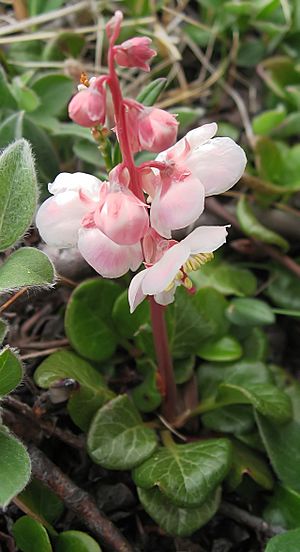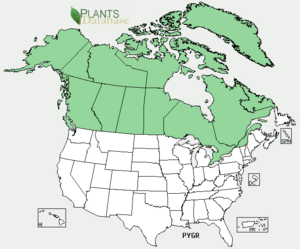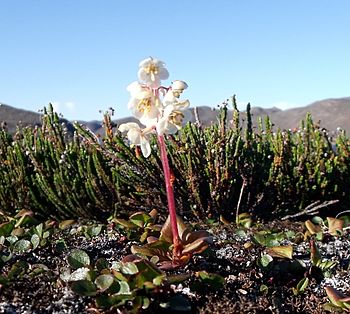Pyrola grandiflora facts for kids
Quick facts for kids Pyrola grandiflora |
|
|---|---|
 |
|
| Scientific classification | |
| Genus: |
Pyrola
|
| Species: |
grandiflora
|
 |
|
| Range of P. grandiflora in North America | |

The Pyrola grandiflora, also known as the largeflowered wintergreen, is a tough, long-lasting plant. It's a type of small, woody plant called a subshrub. This plant stays green all year round, even in winter. It belongs to the Ericaceae family, which also includes blueberries and heather. You can find Pyrola grandiflora all over the Northern Hemisphere, from cooler areas to very cold, icy places like the Arctic.
Contents
What is Pyrola grandiflora?
This plant is a subshrub, which means it's smaller than a bush but has woody stems. It usually grows to be about 3 to 25 centimeters (1 to 10 inches) tall. That's less than half a meter! Its leaves grow from the base of the plant and have long stems.
Leaves of the Largeflowered Wintergreen
The leaves of Pyrola grandiflora are special. They have veins like a feather, with one main vein and smaller ones branching off. The leaf edges are mostly smooth. The top of the leaf is shiny and dark green, feeling a bit like leather. The underside is dull and pale. Sometimes, you might see white lines along the bigger veins on the top side. Since it's an evergreen plant, its leaves stay on the plant all year. They don't fall off in autumn like those of deciduous plants.
Stems and Roots
The main stem of the plant, called a caudex, grows either at ground level or underground. It's short and branches out from a thin underground stem called a rhizome. The plant also has a flowering stem, called a scape, which has one or two small leaves called bracts. The leaf stems (petioles) are flat and smooth. They connect the leaves to the main plant. Pyrola grandiflora has a main root that grows straight down, known as a taproot.
Where Does Pyrola grandiflora Grow?
This plant is found all across the Northern Hemisphere. It grows in many cold regions around the North Pole. This includes places like Greenland, Canada, the United States (especially Alaska), and parts of Europe and Asia. It also thrives in the Arctic regions of Canada, like Nunavut and the Northwest Territories.
What Kind of Places Does it Like?
Pyrola grandiflora prefers certain cold climates, such as those found in taiga (boreal forests) and tundra regions. It can grow in many different types of soil and places. You might find it on rocky slopes, dry meadows, or even in moist areas that don't drain perfectly. It also grows well in heathlands and coniferous forests. In the shrubby tundra, it often grows alongside other plants like Vaccinium uliginosum (bog blueberry) and Salix alaxensis (Alaska willow). This plant usually blooms, or flowers, between April and June.
Flowers and Fruit
The flowers of Pyrola grandiflora are quite large. They have long, pinkish sepals (the leaf-like parts that protect the bud). The petals are greenish-white with a hint of pink and dark veins. The flowers usually grow in a cluster along a central stem, which is called a raceme. Each flower has a smooth stalk called a pedicel.
The flowers have yellow anthers, which are part of the male reproductive system. They also have a long, curved style, which is part of the female reproductive system. This style has a special collar just below its tip. The anthers are about 1.5 to 2 millimeters long. Each flower has one style and one stigma (the tip of the style). It usually has twice as many stamens (male parts) as petals.
How the Fruit Develops
The flower has an ovary made of five fused parts called carpels. Inside, there are many tiny ovules, which will become seeds. The fruit is small and round. It's red when it's young and turns black or brown when it's ripe. The fruit is smooth and about 3 to 6 millimeters long and wide. Each part of the fruit has a ridge down the middle, and inside are the tiny seeds. The seeds are very small, about 0.5 to 0.7 millimeters long. They have a yellowish, smooth endosperm, which provides food for the new plant.
Medicinal Uses
Some other types of Pyrola plants, like Pyrola asarifolia, have been used in traditional medicine. People have used them to help with things like urinary problems, sore throats, and insect bites. However, there haven't been any studies that show Pyrola grandiflora itself has these same medicinal properties.

